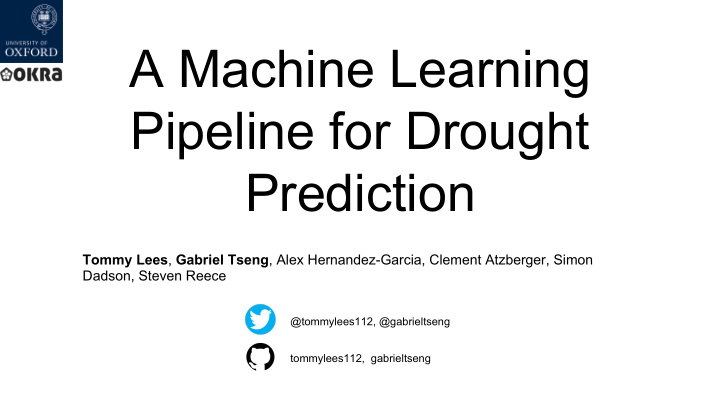



A Machine Learning Pipeline for Drought Prediction Tommy Lees , Gabriel Tseng , Alex Hernandez-Garcia, Clement Atzberger, Simon Dadson, Steven Reece @tommylees112, @gabrieltseng tommylees112, gabrieltseng
Agricultural drought is a significant global problem, and is getting worse. $29 billion in losses to developing world agriculture between 2005 and 2015
Kenya distributes emergency funds using a vegetation index, mitigating the impact of droughts.
We sought a machine-learning based approach to forecast vegetation health. “Information on certain parameters is not only difficult to access … [we also] lack understanding of the different physical processes. This has led to the widespread use and development of data-driven models over process- based models ” Anshuka et. al. 2019
There is friction in applying machine learning to drought forecasting Going from climate data formats (e.g. NetCDF) A very large input space (above: ERA5 land and storage conventions to something which a variables from the Copernicus Climate Data machine learning model can ingest Store)
Our pipeline* aimed to reduce this friction Turn it into machine learning-ready data Plug and play machine Dataset selection and integration learning models *https://github.com/ml-clim/drought-prediction
We used it with the following datasets and models: Copernicus Climate Data Store ERA5 Climate Reanalysis data Persistence Baseline Linear Regression Climate Hazards Group InfraRed Precipitation data (CHIRPS) Linear Neural Network LSTM Global Land Evaporation Amsterdam Model Entity-Aware LSTM Evapotranspiration and Soil Moisture CGIAR-CSI Shuttle Radar Topography Mission Data
Using this pipeline, we were able to achieve results competitive with SOTA to predict vegetation health in Kenya. * * Our predictions are much more spatially granular (pixel wise vs. district wide) than the current SOTA. In order to make models comparable we downscale our predictions to district-level and compare results at this scale. Here we show a table of results for four arid counties in the North of Kenya.
We have started using trained models to investigate the relationships between vegetation health and weather. Lake Turkana
This is how our models need to improve to become operationally useful.
https://github.com/ml-clim/drought-prediction
Recommend
More recommend